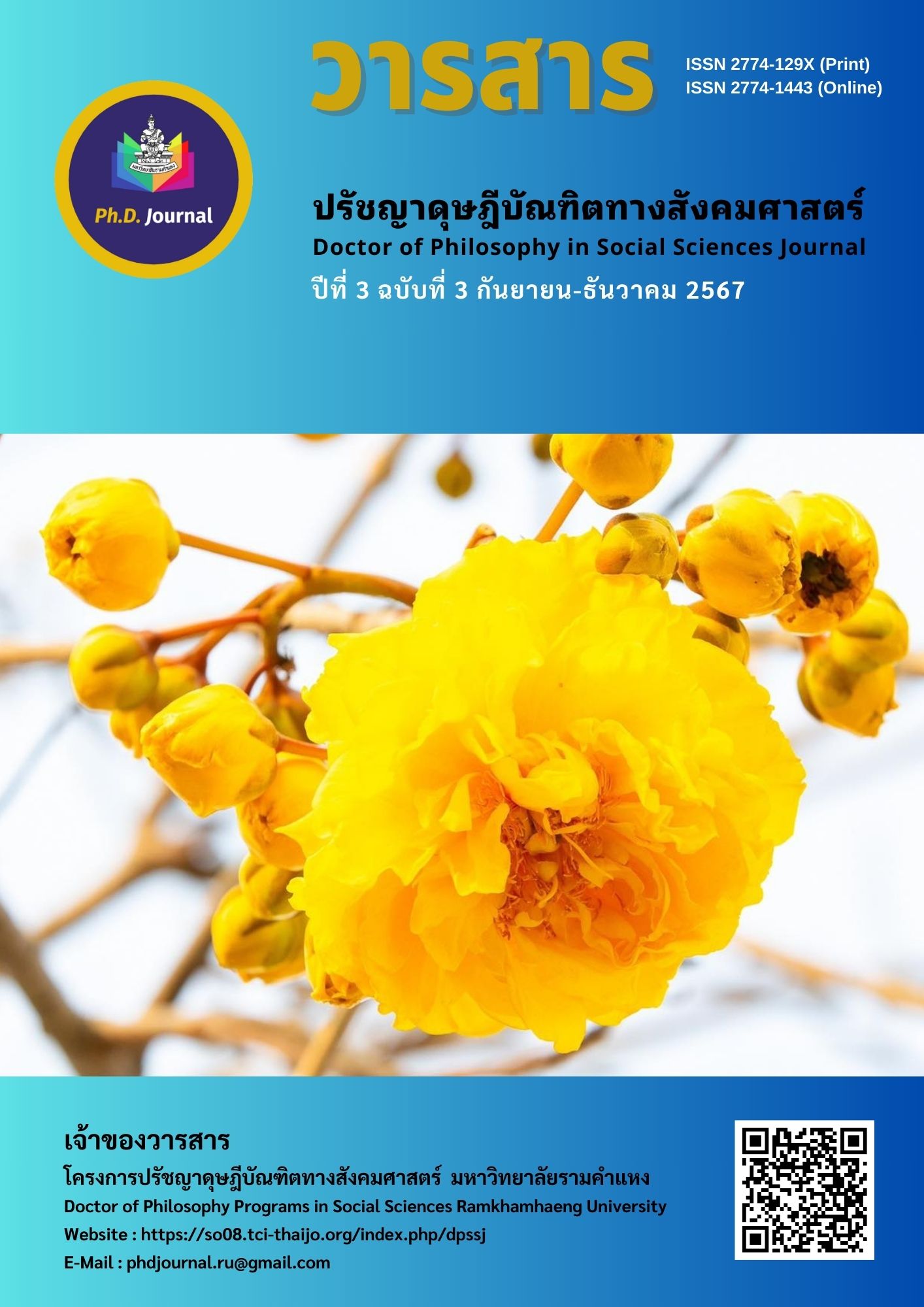การศึกษาปัจจัยที่ส่งผลต่อการนำระบบการวางแผนทรัพยากรองค์การ (ERP) มาใช้งาน ของพนักงานบริษัท เอบีซี (ประเทศไทย) จำกัด
คำสำคัญ:
อิทธิพลของคุณภาพของสารสนเทศ, คุณภาพของระบบ, คุณภาพการบริการ, ความตั้งใจที่จะใช้งานระบบ, ความพึงพอใจของผู้ใช้งานระบบบทคัดย่อ
งานวิจัยนี้มีวัตถุประสงค์เพื่อศึกษา (1) ปัจจัยที่มีผลต่อความตั้งใจที่จะใช้งานระบบการวางแผนทรัพยากรองค์การ ได้แก่ คุณภาพของสารสนเทศ คุณภาพของระบบ และคุณภาพการบริการ (2) ปัจจัยที่มีผลต่อความพึงพอใจของผู้ใช้งานระบบการวางแผนทรัพยากรองค์การ ได้แก่ คุณภาพของสารสนเทศ คุณภาพของระบบ และคุณภาพการบริการ และ (3) ปัจจัยที่มีผลต่อประสิทธิภาพของงานจากการใช้งานระบบการวางแผนทรัพยากรองค์การ ได้แก่ ความตั้งใจที่จะใช้ระบบ และความพึงพอใจ ใช้วิธีการวิจัยเชิงปริมาณ ประชากรที่ศึกษาเป็นผู้ใช้งานระบบการวางแผนทรัพยากรองค์การ การสุ่มตัวอย่างโดยวิธีการสุ่มตัวอย่างแบบง่าย ขนาดตัวอย่าง จำนวน 283 คน การวิจัยเชิงปริมาณใช้การบรรยายโดยสถิติเชิงพรรณนา และการวิเคราะห์สถิติพหุตัวแปรด้วยสถิติวิเคราะห์
ผลการวิจัยพบว่า คุณภาพของสารสนเทศ คุณภาพของระบบ คุณภาพการบริการ ความตั้งใจที่จะใช้งาน และความพึงพอใจของผู้ใช้งานมีอิทธิพลต่อประสิทธิภาพของงานอย่างมีนัยสำคัญ ผลการศึกษานี้สามารถให้ข้อมูลอ้างอิงที่เป็นประโยชน์แก่องค์กร บริษัท นักวิจัย นักวิชาการและบุคคลที่ทำงานในองค์การตลอดจนหน่วยงานที่เกี่ยวข้อง
เอกสารอ้างอิง
สุรสิทธิ์ บุญชูนนท์, และกรวิช เหล่าพิทักษ์โยธิน. (2562). อิทธิพลของคุณภาพระบบสารสนเทศคุณภาพบริการ และคุณภาพ ข้อบังคับต่อความง่ายต่อการใช้งานการรับรู้ประโยชน์ และการยอมรับการใช้งานระบบการเชื่อมโยงข้อมูลอิเล็กทรอนิกส์ของเจ้าหน้าที่ศุลกากร กรมศุลกากรประเทศไทย. วารสารวิชาการคณะบริหารธุรกิจ มหาวิทยาลัยเทคโนโลยีราชมงคลธัญบุรี, 14(1), 73-90.
Automotive S. P., & Homecare, S. P. (2024). บริษัท S.P. Automotive. https://spm-amp.com/auto-parts/
Bansal, P., Gualandris, J., & Kim, N. (2020). Theorizing supply chains with qualitative big data and topic modeling. Journal of Supply Chain Management, 56(2), 7-18.
Battleson, D. A., & Mathiassen, L. (2020). How to turn around a failing Erp implementation: Project management routines as boundary objects. Engaged Management Review, 4(1), 1.
Beselga, D., & Alturas, B. (2019). Using the technology acceptance model (TAM) in SAP Fiori. New Knowledge in Information Systems and Technologies: Volume 1,
Cooper, R. B., & Zmud, R. W. (1990). Information technology implementation research: a technological diffusion approach. Management science, 36(2), 123-139. Davis, F. D. (1989). Perceived usefulness, perceived ease of use, and user acceptance of information technology. MIS Quarterly, 319-340.
Davis, F. D., Bagozzi, R., & Warshaw, P. (1989). Technology acceptance model. J Manag Sci, 35(8), 982-1003. file:///C:/Users/Admin/Downloads/14927137-MIT.pdf
DeLone, W. H., & McLean, E. R. (1992). Information systems success: The quest for the dependent variable. Information systems research, 3(1), 60-95.
DeLone, W. H., & McLean, E. R. (2003). The DeLone and McLean model of information systems success: a ten-year update. Journal of management information systems, 19(4), 9-30.
Deng, H., Duan, S. X., & Wibowo, S. (2023). Digital technology driven knowledge sharing for job performance. Journal of Knowledge Management, 27(2), 404-425.
Grönroos, C., Bernhardt, K. L., & Shostack, G. L. (1983). Comments on Christian Grönroos' Strategic management and marketing in the service sector. (No Title).
Gunawan, S., & Nengzih, N. (2023). The Influence of Accounting Information System Quality, Accounting Information Quality and Accounting Information System Security on End User Satisfaction of S4/Hana System Application Product (SAP) with Perceived Usefulness as a Moderating Variable at PT Hakaaston. Saudi Journal of Economics and Finance, 7, 22-32.
Hair, J. F., Black, W., Babin, B., Anderson, R., & Tatham, R. (2014). Pearson new international edition: Multivariate data analysis. Exploratory Data Analysis in Business and Economics, 23-60.
Henry, J. W., & Stone, R. W. (1995). A structural equation model of job performance using a computer-based order entry system. Behaviour & Information Technology, 14(3), 163-173.
Hidalgo Nuchera, A., Albors Garrigós, J., & Gómez, L. (2011). ERP software selection processes: a case study in the metal transformation sector. Intelligent Information Management, 3(1), 1-16.
Hussain, G., & Yousuf, A. (2024). Head teachers' perspectives on human resource management information system (hrmis) in punjab.
Isnaeningsih, H. N., Fitriati, A., Pujiharto, P., & Astuti, H. J. (2021). The influence Quality of information, Sistem Quality and Service Quality on Satisfaction and User Performace. Jurnal Manajemen Bisnis, 12(2), 266-281.
Katuu, S. (2021). Trends in the enterprise resource planning market landscape. Journal of Information and Organizational Sciences, 45(1), 55-75.
Kettinger, W. J., & Lee, C. C. (1994). Perceived service quality and user satisfaction with the information services function. Decision sciences, 25(5‐6), 737-766.
Lewis, B. R. (1993). Service Quality Measurement. Marketing Intelligence & Planning, 11(4), 4-12.
Momoh, A., Roy, R., & Shehab, E. (2010). Challenges in enterprise resource planning implementation: State‐of‐the‐art. Business Process Management Journal, 16(4), 537-565.
Morris, J. J. (2011). Measuring the impact of enterprise resource planning (ERP) systems on shareholder value. Review of Business Information Systems (RBIS), 15(1), 31-40.
Oliver, R. L. (1980). A cognitive model of the antecedents and consequences of satisfaction decisions. Journal of marketing research, 17(4), 460-469.
Parasuraman, A., Berry, L. L., & Zeithaml, V. A. (1991). Refinement and reassessment of the SERVQUAL scale. Journal of retailing, 67(4), 420.
Parasuraman, A., Zeithaml, V. A., & Berry, L. L. (1985). A conceptual model of service quality and its implications for future research. Journal of marketing, 49(4), 41-50.
Parthasarathy, S., & Padmapriya, S. (2023). Understanding algorithm bias in artificial intelligence-enabled ERP software customization. Journal of Ethics in Entrepreneurship and Technology, 3(2), 79-93.
Purwati, A. A., Mustafa, Z., & Deli, M. M. (2021). Management information system in evaluation of BCA mobile banking using DeLone and McLean model. Journal of Applied Engineering and Technological Science (JAETS), 2(2), 70-77.
Rahayu, U. D., & Chadhiq, U. (2021). The Effect SAP Application System Quality and the Quality of Information on Individual Performance Dimediate User Satisfaction (At PT. PLN (Persero) Central Java And DI Yogyakarta Distribution Main Units). International Journal of Economics, Business and Accounting Research (IJEBAR), 5(2).
Robert Jacobs, F., & ‘Ted’Weston Jr, F. (2007). Enterprise resource planning (ERP)—A brief history. Journal of Operations Management, 25(2), 357-363.
Ross, D. F. (1998). Meeting the challenge of supply chain management. In Competing Through Supply Chain Management: Creating Market-Winning Strategies through Supply Chain Partnerships (pp. 1-35). Springer.
Rovinelli, R. J., & Hambleton, R. K. (1976). On the use of content specialists in the assessment of criterion-referenced test item validity.
Thong, J. Y., & Yap, C.-S. (1996). Information systems effectiveness: A user satisfaction approach. Information Processing & Management, 32(5), 601-610.
Zheng, C., & Kim, S. (2023). The Influence of Enterprise Resource Planning (ERP) System on Customer Satisfaction. AU eJournal of Interdisciplinary Research (ISSN: 2408-1906), 8(2), 1-11.
ดาวน์โหลด
เผยแพร่แล้ว
ฉบับ
ประเภทบทความ
สัญญาอนุญาต
ลิขสิทธิ์ (c) 2024 วารสารปรัชญาดุษฎีบัณฑิตทางสังคมศาสตร์

อนุญาตภายใต้เงื่อนไข Creative Commons Attribution-NonCommercial-NoDerivatives 4.0 International License.



